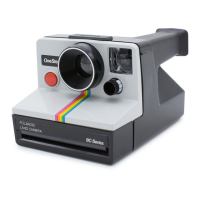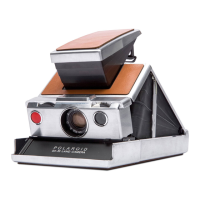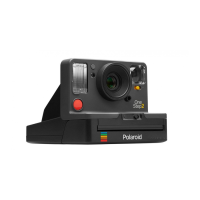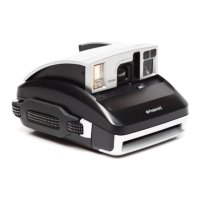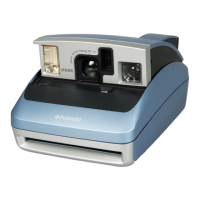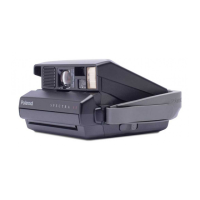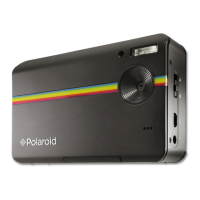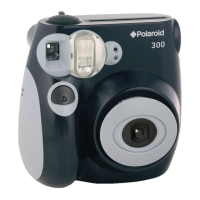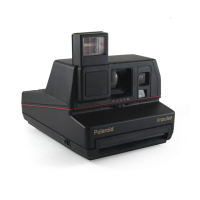
Do you have a question about the Polaroid ONESTEP LAND CAMERA and is the answer not in the manual?
| Brand | Polaroid |
|---|---|
| Model | ONESTEP LAND CAMERA |
| Category | Digital Camera |
| Language | English |
Proof of purchase determines warranty start date; two years from manufacturing if no proof.
Camera mailed from U.S.A. gets postal refund and free film pack upon repair.
Return camera via dealer or mail; call toll-free 800-225-1384 for service.
Excludes damage from misuse/tampering; limits consequential damages.
Position subjects for optimal lighting, use fill-flash for shade or overcast conditions.
Position for light; use support in low light to avoid fuzzy pictures.
Contact Polaroid Customer Service for picture-taking questions and support.
Look through viewfinder, press button for sharp images beyond 4 ft.
Open door, slide film pack in edges-only, close door; camera ejects cover.
Grip firmly, place thumb below counter, index finger on shutter.
Align eye with viewfinder, frame subject, squeeze shutter steadily.
Use FlashBar or Q-Light, position subject for good background illumination.
List of sections covering operation, tips, troubleshooting, and care.
Uses SX-70 film with battery; options include standard FlashBar or Q-Light.
Labeled illustration of camera parts like lens, shutter, viewfinder, and film door.
Keep subjects within 4-9 ft. for optimal flash exposure and clarity.
Use colorful backgrounds; avoid dark or reflective surfaces for best results.
Ensure all subjects in a group are at similar distances for even flash lighting.
Position subjects for side or back lighting; match subject light to background light.
Background brightness can fool the electric eye; adjust for subject exposure.
Shift control towards 'Lighten' when background is very bright to expose subject.
Shift control towards 'Darken' when background is very dark to expose subject.
Combine flash with daylight to expose dark or fuzzy pictures properly.
Use flash to soften facial shadows; move subjects to shade if possible.
Best results achieved when subject is approximately 6 ft. away.
Camera's prefocused lens provides sharp focus from 4 ft. to infinity.
Capture distant subjects and foregrounds sharply; ideal for scenes with multiple planes.
Give subjects activities to appear natural and unposed.
Choose simple backgrounds that complement, rather than distract from, the subject.
Use colorful props, clothing, or backgrounds to add visual interest.
Include foreground elements to frame scenic shots and add depth.
Order high-quality copies and enlargements through your dealer or Polaroid Copy Service.
Optional accessories like Tripod Mount, Self-Timer, and Cable Release enhance usability.
Contact Polaroid experts for assistance with camera, picture, or film issues.
Call toll-free 800-225-1384 or write to Customer Service in Cambridge, MA.
Wipe body with damp cloth; clean lens, viewfinder, and rollers with lint-free cloth.
Store film below 75°F; refrigerate if needed but do not freeze.
Do not leave film or loaded camera in hot places like cars or direct sunlight.
Clean fingerprints gently; SX-70 pictures are stable for display.
Hold camera steady until film ejects to prevent blur.
Use flash or support in dim light; avoid taking pictures in other than bright daylight without it.
Ensure subjects are 4+ ft away; capture action by shooting towards camera.
Check for damaged film packs or leaked developer chemicals on rollers/picture.
Clean dirty rollers inside the camera as described on page 21.
Press shutter, reinsert film pack, or try a new pack if cover doesn't eject.
Check film counter, flash status, or film pack battery; reinsert film pack.
FlashBar works with camera's electric eye; electronic flash needs its own eye for exposure.
Needs own electric eye and sufficient power for well-exposed pictures across its range.
Electronic flash designed for camera, controls output, covers 4-9 ft. range.
Test units before purchase; compare results with FlashBar if issues arise.
Contact Customer Service first; use dealer, mail to nearest Service Center, or bring in.
Return film packs with dead/weak batteries to dealer or Polaroid for replacement.
List of Polaroid Corporation Service Centers in California, Georgia, Hawaii, Illinois, Massachusetts, New Jersey, Texas.
Lists service centers in Australia, Austria, Belgium, Brazil, Canada, Denmark, France, Germany, Great Britain, Hong Kong, Italy, Japan, Mexico, Netherlands, New Zealand, Norway, Panama, Singapore, Sweden, Switzerland, Venezuela.
Jot down camera lot number, date of purchase, and dealer for records.
